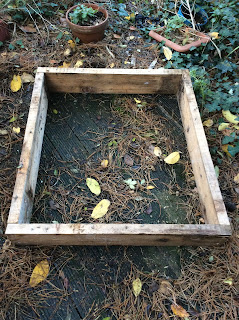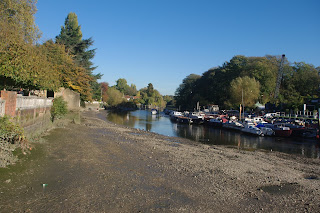A diary of back garden botany, urban ecology, rural rambles and field trips to the middle of nowhere...
Friday, 30 November 2018
Some foggy days in London Town this week made me think back on the Frisco fogs I have known over the years. The traditional English pea-souper is a different beast to the California variety. The fogs of Blighty are the cold damp fogs of a cold climate whereas the fogs of the Bay Area drift in from the Pacific at the height of summer when the landscape is parched and arid. They are indeed chilly and moist but they burn off during the course of the day.
When I was in SF over the summer I did a day hike with a couple of pals along some of the trails on the heights and slopes of the magisterial Mount Tamalpais which looms over the Bay. As the first photograph shows fog banks rolled over the yellowed grasses as we made our way. The ground was dry, too dry by now to sustain much in the way of wildflowers (of which there are many in spring). But a few persist.
We came upon a stand of the pink flowered Tiburon Buckwheat (Erigonium luteolum var. caninum), endemic to this part of California but rare. Touching one of the flowers it was sopping wet like a sponge. I imagine it survives the months of drought by literally sucking moisture out of the air.
Sunday, 25 November 2018
Rich yellows, deep browns and russet reds provide a spectacular finale to autumn then give way to the sombre tones of winter. None the less plenty of greenery remains to lighten the gloom.
Case in point is Arum italicum marmoratum which puts out glossy arrow shaped leaves with marbled white veins and thrives in shady leaf litter. Actually I'm generally not fond of plants with variegated leaves. Plant breeders all too often utilise this trait with garish results but some species have a natural tendency to variegation altogether more pleasing on the eye.
It seems obscure whether marmoratum is a cultivated variety or a subspecies of A. italicum or perhaps it's both of these- a freely occurring hybrid that readily cross breeds with itself. Certainly the veining varies from pronounced to feint.
It's reckoned to have been introduced to the UK from the continental Europe centuries ago. Our native Arum maculatum is widespread in similarly shady woods and hedgerows but has plain green leaves, sometimes with dark blotches but no marbling.
Thursday, 22 November 2018
The back garden is full of leaves. That's good- damp and decaying leaves are one of the sensory delights of autumn.
When I worked in the gardening trade I would spend much of November raking up fallen leaves to cart off the premises in plastic bags. In spring I would purchase plastic bags containing soil improver and haul them onto the premises. It's a living and well-tended gardens are charming in a way.
Unfortunately a lot of gardening is based on the premise that nature is untidy, chaotic even. In fact nature is order on a colossal scale. The leaves fall, the soil improves!
Tuesday, 20 November 2018
California dreaming on such a winter's day. On a particularly cold, wet, grey and dismal London day my thoughts drifted to memories of my hike through the Castle Crags Wilderness in July of this year, also hiking round Crater Lake in Oregon in July 2017 and Mount Shasta in June 2016, another NorCaL landmark. Temperatures in the high 30s, blue sky and bleaching sunlight seem like a dream compared to old London town.
Then again news of the wildfires still raging across California gives me pause for thought. The haze in the first photo is not mist or some artistic filter; that day the air was pungent with smoke blowing downwind from a major wildfire burning 40 or 50 miles to the North. I'll write an entry on this subject in the near future because the volatility of these monumental landscapes is fundamental to appreciating them.
Monday, 19 November 2018
Tuesday, 13 November 2018
Roots and shoots. I wrote a couple of entries about seeds recently. The last one (30th. October) looked at the life cycle of a seed up to the point of germination. One of my flatmates is growing this avocado plant in the kitchen and it provides a good illustration of what comes next.
What we can't see here is the first growth that takes place which is the emergence of the radicle (the embryonic root covered in fine root hairs to absorb water and minerals). The radicle is positively geotrophic i.e. it grows down. This is the consequence of cell division of the epicotyl which is at the base of the radicle and has the effect of anchoring the plant.
Then comes the plumule (the embrionic shoot). It's negatively geotrophic; in other words it grows up! This results from the enlargement of the hypocotyl close to the base of the plumule.
Thus the seed becomes a seedling and eventually a mature plant.
Sunday, 11 November 2018
Well, it's probably not the most significant thing that happened in the world this weekend but I made a raised bed to take to the allotment. In America this is sometimes referred to as "chainsaw carpentry" i.e. not much in the way of finesse but robust and functional.
I cut down a salvaged roof joist to metre lengths then screwed them together. Actually I didn't use a chainsaw and I suppose the purist chainsaw carpenter would have banged it together with 6 inch nails but hey, same difference.
So not significant but it makes me happy...
Saturday, 10 November 2018
I pruned the Lavender last month. The back garden doesn't get enough sun to sustain any of the Lavendulas but a Lavendula x intermedia does fine in the slim, sunny border by the front gate and is bushing up nicely.
Lavendulas are somewhat short lived as perennials go and get increasingly "leggy" as time goes on. They're at they're best for about 7 years with judicious pruning though they'll live longer than that. In fact the one at the front is grown from a cutting of the previous one I planted when I first moved in.
The first thing I do when pruning is nip off all the flower heads to keep in bowls around the house. They have a wonderfully aromatic scent- slightly pungent but fragrant.
Wednesday, 7 November 2018
Here is a fantastic fungus. So much to say about fungi. Mushrooms are the surface fruit of a mycelium which is a mass of thread like hyphae. These organisms can be microscopic in size or huge- some are reckoned to cover thousands of acres (one single organism!).
Scientists and ecologists are becoming ever more interested in the ways in which these networks of mycelia play a vital role in the health of the soil and the symbiotic (i.e. micorrhizal) relationships they have with plants.
Some mushrooms are deadly to humans, some are delicious, some are dangerous or edible depending on where they are found. Mushrooms are filters- if you pick an "edible" variety of mushroom by a motorway it will contain heavy metals; in an ancient woodland the same variety will be full of goodness. Indeed there is developing research into the use of funghi to process pollution. The book "Mycelium Running" by Paul Stamets is subtitled "How mushrooms can help save the world."
And they look amazing. I was on a train heading southwards across London last week which stopped at Barnes station; glancing out the window I saw this superb specimen growing from a tree stump. Camera in hand I hopped off and lingered on the platform till the next train pulled in so I could commune with this magnificent mushroom.
Sunday, 4 November 2018
Anemone blanda is a stalwart of the autumn planted/spring flowering bulbs that appear in the shops in September/October. Above are a handful of of them doing a passable imitation of a pile of boulders though in reality they are about the size of a grape. A. blanda is one of those "bulbs" that should more accurately be referred to as a corm, a distinction I discuss in a recent post (19th. Oct).
When purchased the corms are hard as stones and benefit from being soaked overnight. They flower in spring and the petals range in colour from pure white through to shades of blue, mauve and purple or somewhere in between like this one I photographed a few years ago:
Friday, 2 November 2018
Sweet Thames flow softly. There are stretches of the river between Kew Bridge and Hampton Court which are sometimes described as 'arcadian'. From Tudor times onward a series of palaces, grand houses, landscaped gardens and hunting parks were created among the meadows and woodlands.
I took a stroll from Richmond to Twickenham today on the north side of the Thames path. On a chilly but sunny day it's still one of the more idyllic parts of London. And here's another vision of arcadia:
Thursday, 1 November 2018
Some random happenings in the garden. I said farewell to summer on Sunday when the clocks changed but these Asters are hanging in there having seeded themselves in a crack in the paving stones by the front gate. I notice their petals are more serrated and of a paler mauve than the ones nearby they presumably seeded from.
It's getting to that time of year to fill up the bird feeders.
Lungworts (Pulmonaria species) have delightful spring flowers in tones of pink that morph into blue. Their leaves are mottled in varying degrees so they stand out in winter borders in a modest sort of way. I've been growing several varieties in pots during the summer and I planted them this week in an area where there are a number already. Pulmonarias cross pollinate easily (they're a favourite of early bees) and the progeny have further variations of foliage and flower.
Potting up, potting on and generally going a bit potty.
Subscribe to:
Comments (Atom)



























